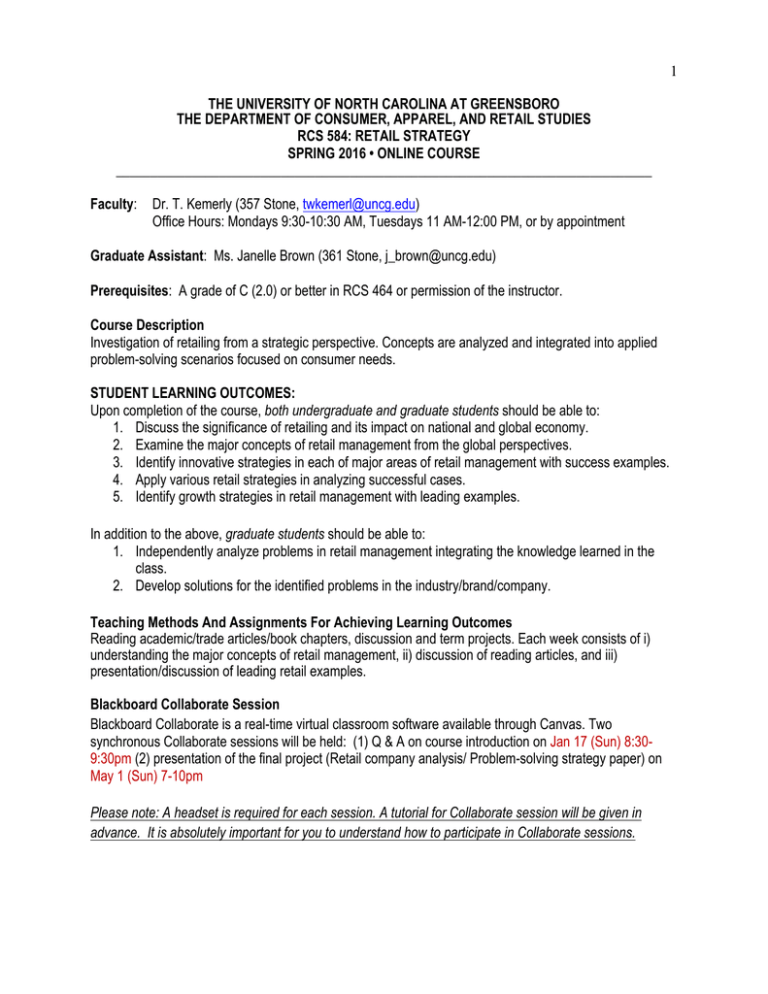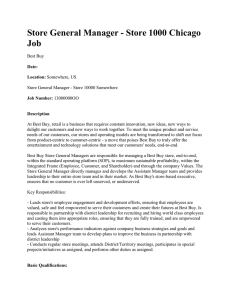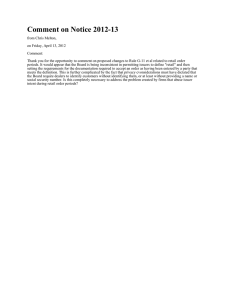1 THE UNIVERSITY OF NORTH CAROLINA AT GREENSBORO
advertisement

1 THE UNIVERSITY OF NORTH CAROLINA AT GREENSBORO THE DEPARTMENT OF CONSUMER, APPAREL, AND RETAIL STUDIES RCS 584: RETAIL STRATEGY SPRING 2016 • ONLINE COURSE ______________________________________________________________________________ Faculty: Dr. T. Kemerly (357 Stone, twkemerl@uncg.edu) Office Hours: Mondays 9:30-10:30 AM, Tuesdays 11 AM-12:00 PM, or by appointment Graduate Assistant: Ms. Janelle Brown (361 Stone, j_brown@uncg.edu) Prerequisites: A grade of C (2.0) or better in RCS 464 or permission of the instructor. Course Description Investigation of retailing from a strategic perspective. Concepts are analyzed and integrated into applied problem-solving scenarios focused on consumer needs. STUDENT LEARNING OUTCOMES: Upon completion of the course, both undergraduate and graduate students should be able to: 1. Discuss the significance of retailing and its impact on national and global economy. 2. Examine the major concepts of retail management from the global perspectives. 3. Identify innovative strategies in each of major areas of retail management with success examples. 4. Apply various retail strategies in analyzing successful cases. 5. Identify growth strategies in retail management with leading examples. In addition to the above, graduate students should be able to: 1. Independently analyze problems in retail management integrating the knowledge learned in the class. 2. Develop solutions for the identified problems in the industry/brand/company. Teaching Methods And Assignments For Achieving Learning Outcomes Reading academic/trade articles/book chapters, discussion and term projects. Each week consists of i) understanding the major concepts of retail management, ii) discussion of reading articles, and iii) presentation/discussion of leading retail examples. Blackboard Collaborate Session Blackboard Collaborate is a real-time virtual classroom software available through Canvas. Two synchronous Collaborate sessions will be held: (1) Q & A on course introduction on Jan 17 (Sun) 8:309:30pm (2) presentation of the final project (Retail company analysis/ Problem-solving strategy paper) on May 1 (Sun) 7-10pm Please note: A headset is required for each session. A tutorial for Collaborate session will be given in advance. It is absolutely important for you to understand how to participate in Collaborate sessions. 2 ASSIGNMENTS FOR ACHIEVING LEARNING OUTCOMES This class is designed to be a discussion class; Discussion is an essential part of learning so students are strongly encouraged to actively participate in the discussion. For this, it is absolutely imperative that you read the readings prior to online discussion. Each week consists of three discussion forums: two forums for two reading articles provided by instructor (one forum for each article) + one forum for two leading retail examples uploaded by student group. Each discussion forum will allow threaded discussions. Below are components of this class throughout the semester. 1. Article summary and discussion questions (80pts = 40pts/article x 2; group project; 3-4 in a group for both undergraduates and graduate students): Your group will be randomly assigned to two articles for which you will be in charge of i) summarizing the major points of the article (no more than 15 slides) (20pts) and ii) developing three thought-provoking and stimulating discussion questions (DQs) (20pts). These PPT file and three DQs need to be emailed instructor and GA by Mon 9:00am EST. Please note that failing to email PPT and three DQs to instructor/GA by Monday 9:00am will result in a 5-point deduction. Also note that the three questions should i) be related to the reading article topic, ii) be based on the facts in the reading article, and iii) require some thinking. So questions that can be answered without thorough understanding of a reading article such as sharing experiences or feelings are NOT thoughtprovoking or stimulating questions, which may result in losing points. 2. Leading retail examples (40 points = 20pts for one leading example x 2 examples; group project; same group as with above discussion leadership): This assignment is to find two leading examples for the given topic for a week (such as niche positioning, social media, PR, etc.) from trade journals. Trade journals include Apparel Magazine, The Wall Street Journal, Fortune, Forbes, Stores, Chain Store Age, Business Week, etc. Your group will be randomly assigned to a weekly topic. Your group is expected to A) choose two trade articles in the apparel and/or retail industry that are very current (i.e., after 2000) and closely related to a weekly topic (20pts, 10pts each), and B) email the instructor and GA the articles with a very brief summary and implications for U.S. apparel and/or retail industry (20pts, 10pts each) by Mon 9:00am for the given week. You can put the brief summary and implications in the email as text, not a separate file in MS word. The trade article itself should be saved in MS word (not pdf) without advertisement. This means that you will need to edit the trade article if you download it from a website. Please be sure to include a web link of the article and the source of the article in APA style and on top of first page in MS word file. 3. Discussion Participation: 1) Reading article discussion (144 points = 2pts/discussion question x 6 questions/week x 12 weeks with reading articles): Article discussion for a week consists of six discussion questions (3 discussion questions x 2 reading articles). For each question, you must post one response to each question (1pt x 6 responses= 6pts) plus one response/question to one posting of your class peers (1pt x 6 responses/questions = 6pts). So each week, you will receive 12pts (2 postings for each article x 6 discussion questions = 12pts) for participating in article discussion. Both quantity and quality of participation will be graded. Just simple reply such as “I agree with you” “I like your idea” and “Very good point” will not count. Reply should include your thinking paths (i.e., why you agree/disagree, etc.). The instructor will monitor and interject as needed. 3 2) Leading example discussion (48pts = 2pts/leading example x 2 examples/week x 12 weeks with leading examples): You will have two leading example articles posted each week. You will need to post one response as to why/how the posted trade article is related to the given topic for the week and implication for U.S. apparel and/or retail industry (2pts for a posting x 2 trade articles = 4pts for a week). Note: Discussion for each week starts Mon 9:00am EST and ends Sun midnight EST (i.e., Sun 11:59pm). For example, Week 1 starts Jan 11 (Mon) 9:00am and ends Jan 17 (Sun) midnight. Discussion questions and leading example articles will be posted no later than Mon 12:00pm (noon). This means that you will need to post questions and responses during this time frame each week. To facilitate the discussion above, students will be assigned into a group of roughly nine to ten students and the groups will be shuffled about four times in this semester to allow more interaction. 4. Retail company analysis (120 pts; undergraduate students only; Group project; 3-4 persons in a group): There are numerous successful/failure cases in retail industry. Choose a company (brand) that has not been discussed in the class and analyze reasons for the success/failure. There are three components of the final project with due dates throughout the semester. Detailed instruction and evaluation rubrics will be provided. Component 1 (Due Feb 8, 9am): Company (brand) overview (History, target market, positioning, financial performance, etc.) Component 2 (Due Mar 14, 9am): Description of success/failure and SWOT analysis Component 3 (Due Apr 18, 9am): Suggest growth directions. All Components (final retail company analysis paper): Due May 1. Sun.12:00pm (Noon). 5. Problem-solving strategy paper (120 pts; graduate students only; individual project): This will be the final product of this class. As such, this assignment will require an integrative analysis. There are three components of the final project with due dates throughout the semester. Detailed instruction and evaluation rubrics will be provided. Component 1 (Due Feb 8, 9am): Identification of problem(s) encountered by the industry/ a company/ or a brand. Component 2 (Due Mar 14, 9am): Current approach and problems of current approach. Component 3 (Due Apr 18, 9am): Potential solutions and plans to achieve the solutions. All Components (final problem-solving strategy paper): Due May 1. Sun.12:00pm (Noon). *Report Format (retail company analysis/problem-solving strategy): Your paper should be 15-20 pages long including everything using 12 Times New Roman font and double spaced with 1 inch margin on all sides. Your paper should begin with a cover page (title of the project, name) and a table of contents, a list of tables and figures (each of the former items should have a separate page regardless of its length), and should end with a reference list (APA style)*. Please carefully review and proofread prior to submission. Papers will be expected to be error-free (spelling, grammar, punctuation, and content). * You need to refer at least ten sources for each project and these sources need to be listed in the reference list. Citing only web links will result in losing points. Please note that plagiarism will be checked with the function of tunitin.com available on Canvas. 4 6. Presentation (18 pts; group project for undergraduates and individual project for graduates): You (or group) will be required to make a 12min presentation to the class via Collaborate sessions (May 1). The specifics of the presentation will be discussed as the due date approaches. An oral presentation evaluation rubric will be given prior to the presentation. EVALUATION: For Undergraduate Students Article summary and discussion questions Leading retail example Reading article discussion participation Leading example article discussion participation Retail company analysis paper Presentation Total 80pts 40pts 144pts 48pts 120pts 18pts 450pts For Graduate Students Article summary and discussion questions Leading retail example Reading article discussion participation Leading example article discussion participation Problem-solving strategy paper Presentation Total 80pts 40pts 144pts 48pts 120pts 18pts 450pts FINAL GRADES For Graduate Students: A = 419-450 B+ = 392-404 C+ = 347-359 F = 314 or below For Undergraduate Students: A+ = 437-450 B+ = 392-404 C+ = 347-359 D+ = 302-314 F = 269 or below A- = 405-418 B = 374-391 C = 315- 384 B- = 360-373 A = 419-436 B = 374-391 C = 329-346 D = 284-301 A- = 405-418 B- = 360-373 C- = 315-328 D- = 270-283 SUGGESTED TEXTS/READING Specific reading assignments for each week will be comprised of book chapters, academic/trade articles, consulting reports and case studies. Most readings will be posted on the Canvas with the exception of seven HBR (Harvard Business School) cases with copyright issues. These seven cases (highlighted in yellow in the reading list) can be purchased at below link at discounted rate ($3.95/case). For the purchase, you will need to create an account and the cases can be downloaded upon payment https://cb.hbsp.harvard.edu/cbmp/access/32709256 5 ACADEMIC INTEGRITY POLICY Each student is required to sign the Academic Integrity Policy on all major work submitted for the course. Refer to the following URL: http://sa.uncg.edu/handbook/academic-integrity-policy/ POLICY ON LATE SUBMISSION If your assignment is submitted late, 10% of the assigned grade for that particular assignment will be deducted each day after the due date. TOPICAL OUTLINE/CALENDAR Week/Dates Topic Chapter1 Week 1: Jan 11-17 Class overview, Introduction to the world of retailing Chap 1, 2, & 3 Week 2: Jan 19-242 Customer buying behavior Chap 4 Week 3: Jan 25-31 Differentiation & Niche positioning Week 4: Feb 1-7 Week 5: Feb 8-14 Week 6: Feb 15-21 Week 7: Feb 22-28 Week 8: Feb 29-Mar 6 Human Resource Management Chap 9 Information systems and SCM Problem-solving paper component #1 DUE (graduate) Retail company analysis component #1 DUE (undergraduate) Chap10 Merchandise development/ buying & assortment management Chap13 Cont’d Chap13 Retail communication & social media Chap 15 Week 9: Mar 7-13 Week 10: Mar 14-20 Week 11: Mar 21-27 Week 12: Mar 28-Apr 3 Week 13: Apr 4-10 Week 14: Apr 11-17 Week 15: Apr 18-24 Spring Break (No Class) Managing store, store layout, design and visual merchandising Problem-solving paper component #2 DUE (graduate) Retail company analysis component #2 DUE (undergraduate) Chap 16 & 17 Customer service Chap 18 Retail strategies: Growth opportunities Chap 5 Retail strategies: Global opportunities Chap 5 Success/Failure Cases in Global Markets Problem-solving paper component #3 DUE (graduate) Retail company analysis component #3 DUE (undergraduate) Final problem-solving paper/ retail company analysis DUE (May 1: Sun 12pm) & Presentation and discussion Collaborate Session (May 1: Sun 7-10pm) 1 Textbook chapters are required to understand before class discussion. There will be no lecture for each chapter while a summary of each chapter may be given. 2 Martin Luther King Jr.’s Holiday is observed, so Wk 2 starts Jan 19 (Tues), not Jan 18 (Mon). Week 16: Apr 25-May 1 6 Tentative Reading List Week 2 (Jan 19-Jan 24). Customer buying behavior _________________________________________ Dimofte, C. V., Johansson, J. K., & Bagozzi, R. P. (2010). Global brands in the United States: How consumer ethnicity mediates the global brand effect. Journal of International Marketing, 18(3), 81-106. Atsmon, Y., Dixit, V., & Wu, C. (2011). Tapping China’s luxury-goods market. McKinsey Quarterly. Further reading Anderson, T. (2011, October 23). Luxury retailers banking on China. The Wall Street Journal. Retrieved from http://search.proquest.com/wallstreetjournal/docview/900137214/132A3E3C73033800921/1?accou ntid=14604 Rein, S. (2011, Mar 29).Who Buys Guccis and Omegas in China? Not Just the Billionaires. Retrieved from http://www.cnbc.com/id/42315036 Week 3 (Jan 25-31). Differentiation & Niche positioning ______________________________________ Parrish, E. (2010). Retailers' use of niche marketing in product development. Journal of Fashion Marketing and Management, 14 (4), 546 – 561. Surchi, M. (2011). The temporary store: A new marketing tool for fashion brands. Journal of Fashion Marketing and Management, 15(2), 257-270. Week 4 (Feb 1-7). Human Resource Management____________________________________________ Bendapudi, B., & Bendapudi, V. (2005). Creating the living brand. Harvard Business Review, 83(5), 124-131. Ton, Z. (2012). Why “good jobs” are good for retailers. Harvard Business Review, 90(1/2), 124-131. Week 5 (Feb 8-14). Information System & SCM _____________________________________________ Fisher, M.L. (1997). What is the right supply chain for your product? Harvard Business Review, 75(2), 105-116. Marks, M., Holloway, C., Lee, H., Hoyt, D., & Silverman, A. (2011). Crocs: Revolutionizing an industry supply chain model for competitive advantage. GSB No. GS-57. Standford, CA: Stanford Graduate School of Business Publishing (Can be purchased at HBR). Week 6 (Feb 15-21). Merchandise Development/Buying & Assortment Management ______________ Fisher, M. L., & Vaidyanathan, R. (2012). Which products should you stock? Harvard Business Review, 90(11), 108-118. Yen, B., & Farhoomand, A., & Khan, S. (2006). Polo Ralph Lauren & Luen Thai: Using collaborative supply chain integration in the apparel value chain. Asia Case Research Centre Case #HKU596. (Can be purchased at HBR). Week 7 (Feb 22-28). Merchandise Development/Buying & Assortment Management ______________ Abernathy, F. H., Dunlop, J. T., Hammond, J. H., & Weil, D. (2000). Control your inventory in a world of lean retailing. Harvard Business Review, 78(6), 169-176. Nunes, P. F., Narendra, M., Giorgio, B., Taggart, M. J., & Cummings, C. S. (2008). Can knockoffs knock out your business? Harvard Business Review, 86(10), 41-50. 7 Week 8 (Feb 29-Mar 6). Retail Communication Mix & Social Media_____________________________ Ofek, E., & Wagonfeld, A. B. (2011). Sephora direct: Investing in social media, video, and mobile. HBS No. 9-511-137. Boston, MA: Harvard Business School Publishing. (Can be purchased at HBR). Tripp, T. M., & Gregoire, Y. (2011). When unhappy customers strike back on the internet. MIT Sloan Management Review, 52(3), 37-44. Week 10 (Mar 14-20). Managing Store, Store Layout, Design and Visual Merchandising____________ Michon, R., Chebat, J-C., & Turley, L. W. (2005). Mall atmospherics: The interaction effects of the mall environment on shopping behavior. Journal of Business Research, 58, 576-583. Lohse, G. L. & Spiller, P. (1999). Internet retail store design: how the user interface influences traffic and sales. Journal of Computer Mediated Communication, 5(2). Retrieved from http://jcmc.indiana.edu/vol5/issue2/lohse.htm Week 11 (Mar 21-27) Customer Service ____________________________________________________ King, T. (2004). Deshopping: Retail perspective on the mismanagement and prevention of deshopping. European Retail Digest, 14, 61-64. Frei, F. X., Ely, R. J., & Winig, L. (2011). Zappos.com 2009: Clothing, customer service, and company culture. HBS No. 9-610-015. Boston, MA: Harvard Business School Publishing. (Can be purchased at HBR). Week 12 (Mar 28-Apr 3). Retail Growth Opportunities ________________________________________ Fox, E. J., & Sethuraman, R. (2010). Retail competition. In Kraft, M., & Mantrala, M. K. (Eds.), Retailing in the 21st Century (pp. 239-256), New York, NY: Springer. Keinan, A., Avery, J., Wilson, F., Norton, M. I. (2012). Eileen Fisher: Repositioning the brand. HBS No. 9-512-085. Boston, MA: Harvard Business School Publishing. Week 13 (Apr 4-10). Retail Strategies: Global Opportunities ______________________________________ Keller, C., Magnus, K-H., Nava, P. Hedrich, S., & Tochtermann, T. (2014). Succeeding in tomorrow’s global fashion market. McKinsey & Company. Gao, G. Y., Lu, J., & Fung, H-G. (2008). Ports: China’s walk on the global luxury fashion boulevard. Asia Case Research Centre Case #HKU749. (Can be purchased at HBR). Week 14 (Apr 11-Apr 17). Success/Failure Cases in Global Markets_______________________________ McFarlanm F. W., Chen, M. S-T., & Wong, K. C-H. (2012). Li & Fung 2012. HBS No. 312102PDF-ENG. Boston, MA: Harvard Business School Publishing. (Can be purchased at HBR). Burt, S., & Sparks, L. (2006). Wal-Mart’s world. In Brunn, S. D. (eds). Wal-Mart world: The world’s biggest corporation in the global economy (pp.27-43). New York, NY: Routledge.







![[Company Name]](http://s3.studylib.net/store/data/009539562_1-20bba15a42c559f6e2eb5e3c0022265d-300x300.png)